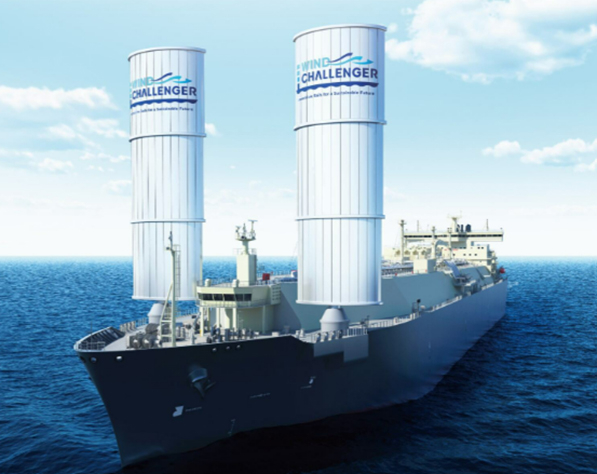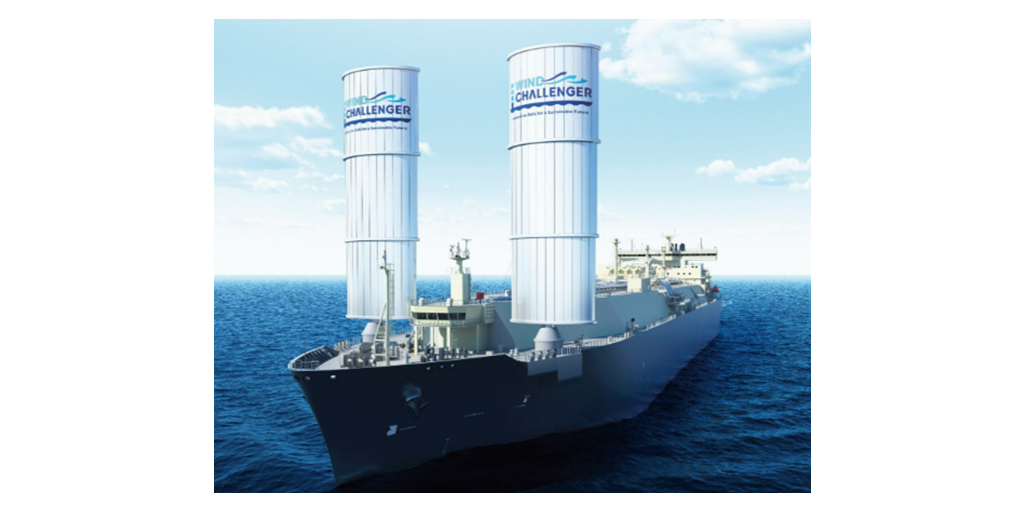
Chevron Shipping Company and MOL to Install Wind Challenger on LNG Carrier
Wind-Assisted Ship Propulsion System is an LNG Shipping First
SAN RAMON, Calif. & TOKYO–(BUSINESS WIRE)–As part of their ongoing commitment to lower the carbon intensity of their operations, Chevron Shipping Company LLC (Chevron), a subsidiary of Chevron U.S.A. Inc., and Mitsui O.S.K. Lines, Ltd. (MOL) announced an agreement to install Wind Challenger, a hard sail wind-assisted ship propulsion system developed by MOL and Oshima Shipbuilding together (Note 1), to a new build LNG carrier under long term charter from MOL Encean Pte. Ltd. (MOL’s 100% indirectly owned subsidiary) to Chevron Asia Pacific Shipping Pte. Ltd. This vessel will mark the world’s first LNG carrier equipped with Wind-Assisted Ship Propulsion Systems.
The vessel is under construction at the Geoje Shipyard of Hanwha Ocean Co., Ltd. and is scheduled for delivery in 2026. In August 2024, MOL obtained an approval in principle (AiP) by Nippon Kaiji Kyokai (Class NK) – a first for an LNG carrier with a Wind-Assisted Ship Propulsion System (Note 2). The Chevron chartered vessel will be the first application.
Wind Challenger will help reduce fuel consumption and GHG emissions by using its unique telescopic sails.
In addition to the robust design of Wind Challenger itself, additional safety measures include a fully enclosed navigation bridge and a lookout station on the vessel’s fore deck to further enhance visibility.
For tradability, the installation position of the Wind Challenger aims to minimize impact on the existing design of membrane type LNG Carriers. It will enable the retention of the existing mooring arrangement unchanged and thereby minimize impacts on ship shore compatibility, together with limited impact on the vessel’s windage area.
“We’re proud to partner with MOL in Wind Challenger’s industry-first LNG installation,” said Barbara Pickering, President of Chevron Shipping Company. “This is another example of using novel approaches in hard-to-abate sectors to reduce carbon intensity in our LNG fleet.”
Takeshi Hashimoto, President, and CEO of Mitsui O.S.K. Lines, said, “With the understanding and cooperation of Chevron, we are delighted to be able to expand the Wind Challenger Project to LNG carriers in addition to the two delivered Wind Challenger-equipped bulkers (Note 3) and other ongoing projects (Note 4). Achieving GHG reduction in the maritime transport of LNG, which is increasingly in demand worldwide as a transition fuel, is a very important mission for us. This project will undoubtedly be a significant milestone towards achieving ‘net-zero emissions by 2050’, a medium to long-term goal of the Mitsui O.S.K. Lines Group, as stated in our ‘Environmental Vision 2.2‘.”
The Wind Challenger technology will be on exhibit at the MOL booth at the Gastech Exhibition & Conference 2024 in Houston, September 17-20. Information sessions on how the technology can be applied to both LNG carriers and other vessels will also be held.
<Vessel Outline>
|
Ship Owner
|
MOL Encean Pte. Ltd. |
|
LOA / Breadth
|
About 286 m / About 46 m |
|
Cargo Tank Capacity
|
About 174,000 m3 |
|
Shipyard
|
Hanwha Ocean Co., Ltd. |
|
Wind Challenger Specifications |
Number of Sail: 2 Height: Up to 49 m (3-tier) Width: About 15 m Sail material: Fiber Reinforced Plastic |
(Note 1) For details, please refer to the following web site.
Wind Challenger: The Wind Assisted Ship Propulsion System | SERVICES | Mitsui O.S.K. Lines, Ltd. Solutions (mol-service.com)
(Note 2) For details, please refer to the following press release.
MOL Obtains AiP for “LNG Carrier Installing Wind Challenger” – The World’s First Approval for an LNG Carrier – | Mitsui O.S.K. Lines
(Note 3) For details, please refer to the following press releases.
Delivery of SHOFU MARU, World’s First Cargo Vessel equipped with ‘Wind Challenger’ Hard Sail | Mitsui O.S.K. Lines
MOL Announces Delivery of Bulk Carrier Green Winds, 2nd Vessel Equipped with Wind Challenger Hard Sail Propulsion System | Mitsui O.S.K. Lines
(Note 4) For details, please refer to the following press releases.
Wind Challenger to be Installed on Coal Carrier for J-Power – World’s 1st Retrofit on an In-service Vessel – | Mitsui O.S.K. Lines
Wind Propulsion Systems will be Installed on 7 Vessels Operated by MOL Drybulk – Steadily Pursuing to ’25 Wind Challenger-equipped Vessels’ by 2030 – | Mitsui O.S.K. Lines
About Chevron:
Chevron is one of the world’s leading integrated energy companies. We believe affordable, reliable and ever cleaner energy is essential to enabling human progress. Chevron produces crude oil and natural gas; manufactures transportation fuels, lubricants, petrochemicals and additives; and develops technologies that enhance our business and the industry. We aim to grow our oil and gas business, lower the carbon intensity of our operations and grow lower carbon businesses in renewable fuels, carbon capture and offsets, hydrogen and other emerging technologies. More information about Chevron is available at www.chevron.com.
About MOL:
MOL is a leading shipping company, operating on a global scale with more than 800 vessels in service. The company develops various social infrastructure businesses centered on ocean shipping, as well as technologies and services to meet ever-changing social needs including environmental protection. The MOL fleet includes dry cargo ships, liquefied natural gas (LNG) carriers, car carriers, and tankers. In addition to the traditional shipping businesses, MOL also offers wellbeing & lifestyle businesses such as real property, terminal operation, and ferry service, as well as social infrastructure businesses such as logistics and offshore wind power. With one of the largest merchant fleets and about 140 years of history, experience, and technology, MOL will make a leap forward to become a global social infrastructure company, support people’s daily lives from the blue ocean, open the way to a prosperous future, and deliver new value to all stakeholders.
Website: https://www.mol.co.jp/en/
CAUTIONARY STATEMENTS RELEVANT TO FORWARD-LOOKING INFORMATION FOR THE PURPOSE OF “SAFE HARBOR” PROVISIONS OF THE PRIVATE SECURITIES LITIGATION REFORM ACT OF 1995
This news release contains forward-looking statements relating to Chevron’s operations and lower carbon strategy that are based on management’s current expectations, estimates, and projections about the petroleum, chemicals and other energy-related industries. Words or phrases such as “anticipates,” “expects,” “intends,” “plans,” “targets,” “advances,” “commits,” “drives,” “aims,” “forecasts,” “projects,” “believes,” “approaches,” “seeks,” “schedules,” “estimates,” “positions,” “pursues,” “progress,” “may,” “can,” “could,” “should,” “will,” “budgets,” “outlook,” “trends,” “guidance,” “focus,” “on track,” “goals,” “objectives,” “strategies,” “opportunities,” “poised,” “potential,” “ambitions,” “aspires” and similar expressions, and variations or negatives of these words, are intended to identify such forward-looking statements, but not all forward-looking statements include such words. These statements are not guarantees of future performance and are subject to numerous risks, uncertainties and other factors, many of which are beyond the company’s control and are difficult to predict. Therefore, actual outcomes and results may differ materially from what is expressed or forecasted in such forward-looking statements. The reader should not place undue reliance on these forward-looking statements, which speak only as of the date of this news release. Unless legally required, Chevron undertakes no obligation to update publicly any forward-looking statements, whether as a result of new information, future events or otherwise.
Among the important factors that could cause actual results to differ materially from those in the forward-looking statements are: changing crude oil and natural gas prices and demand for the company’s products, and production curtailments due to market conditions; crude oil production quotas or other actions that might be imposed by the Organization of Petroleum Exporting Countries and other producing countries; technological advancements; changes to government policies in the countries in which the company operates; public health crises, such as pandemics and epidemics, and any related government policies and actions; disruptions in the company’s global supply chain, including supply chain constraints and escalation of the cost of goods and services; changing economic, regulatory and political environments in the various countries in which the company operates; general domestic and international economic, market and political conditions, including the military conflict between Russia and Ukraine, the conflict in Israel and the global response to these hostilities; changing refining, marketing and chemicals margins; actions of competitors or regulators; timing of exploration expenses; timing of crude oil liftings; the competitiveness of alternate-energy sources or product substitutes; development of large carbon capture and offset markets; the results of operations and financial condition of the company’s suppliers, vendors, partners and equity affiliates; the inability or failure of the company’s joint-venture partners to fund their share of operations and development activities; the potential failure to achieve expected net production from existing and future crude oil and natural gas development projects; potential delays in the development, construction or start-up of planned projects; the potential disruption or interruption of the company’s operations due to war, accidents, political events, civil unrest, severe weather, cyber threats, terrorist acts, or other natural or human causes beyond the company’s control; the potential liability for remedial actions or assessments under existing or future environmental regulations and litigation; significant operational, investment or product changes undertaken or required by existing or future environmental statutes and regulations, including international agreements and national or regional legislation and regulatory measures related to greenhouse gas emissions and climate change; the potential liability resulting from pending or future litigation; the risk that regulatory approvals with respect to the Hess Corporation (Hess) transaction are not obtained or are obtained subject to conditions that are not anticipated by the company and Hess; potential delays in consummating the Hess transaction, including as a result of regulatory proceedings or the ongoing arbitration proceedings regarding preemptive rights in the Stabroek Block joint operating agreement; risks that such ongoing arbitration is not satisfactorily resolved and the potential transaction fails to be consummated; uncertainties as to whether the potential transaction, if consummated, will achieve its anticipated economic benefits, including as a result of regulatory proceedings and risks associated with third party contracts containing material consent, anti-assignment, transfer or other provisions that may be related to the potential transaction that are not waived or otherwise satisfactorily resolved; the company’s ability to integrate Hess’ operations in a successful manner and in the expected time period; the possibility that any of the anticipated benefits and projected synergies of the potential transaction will not be realized or will not be realized within the expected time period; the company’s future acquisitions or dispositions of assets or shares or the delay or failure of such transactions to close based on required closing conditions; the potential for gains and losses from asset dispositions or impairments; government mandated sales, divestitures, recapitalizations, taxes and tax audits, tariffs, sanctions, changes in fiscal terms or restrictions on scope of company operations; foreign currency movements compared with the U.S. dollar; higher inflation and related impacts; material reductions in corporate liquidity and access to debt markets; changes to the company’s capital allocation strategies; the effects of changed accounting rules under generally accepted accounting principles promulgated by rule-setting bodies; the company’s ability to identify and mitigate the risks and hazards inherent in operating in the global energy industry; and the factors set forth under the heading “Risk Factors” on pages 20 through 26 of the company’s 2023 Annual Report on Form 10-K and in subsequent filings with the U.S. Securities and Exchange Commission. Other unpredictable or unknown factors not discussed in this news release could also have material adverse effects on forward-looking statements.
Contacts
Christine Dobbyn
External Affairs Advisor, Chevron
Tel: +1 281-906-1499
Mitsui O.S.K. Lines, Ltd.
Corporate Communications Division, Media Relations Team
E-mail: mrtmo@molgroup.com/TEL: 03-3587-7015



